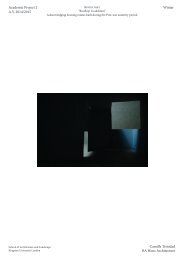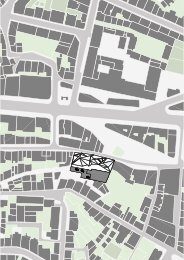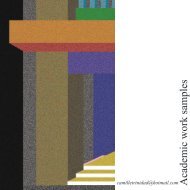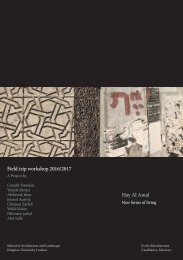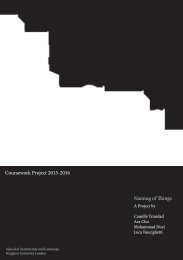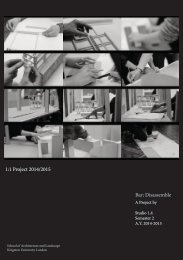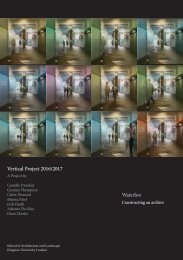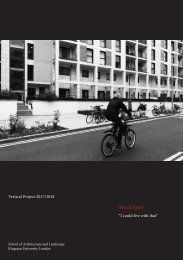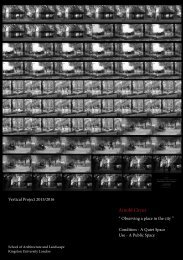National Theatre of the Philippines
My final year dissertation which explored a symbolic edifice in Manila, built by the National Artist for Architecture as per request of the former First Lady of the Philippines. It discusses Architecture's innate role in a political society, specifically in a country that has undergone centuries of colonialism; which got an overall grade of A.
My final year dissertation which explored a symbolic edifice in Manila, built by the National Artist for Architecture as per request of the former First Lady of the Philippines. It discusses Architecture's innate role in a political society, specifically in a country that has undergone centuries of colonialism; which got an overall grade of A.
You also want an ePaper? Increase the reach of your titles
YUMPU automatically turns print PDFs into web optimized ePapers that Google loves.
The Common denominator<br />
Was <strong>the</strong>re a mutual goal between <strong>the</strong> architecture <strong>of</strong> Leandro Locsin and <strong>the</strong> Marcos<br />
Regime?<br />
Manila as a primate city (<strong>the</strong> largest city in its country, disproportionately larger than<br />
any o<strong>the</strong>rs in <strong>the</strong> urban hierarchy)<br />
41<br />
is conditioned by <strong>the</strong> geographic, economic and<br />
political setup all <strong>of</strong> which in turn affect <strong>the</strong> development <strong>of</strong> architecture in <strong>the</strong><br />
country. 42 The essence <strong>of</strong> architecture is immaterial. It concerns itself with values and<br />
inspirations with meanings, as some want to call <strong>the</strong> non-physical side <strong>of</strong> architecture. It<br />
is expressed by a significant architectural form.<br />
43<br />
On December <strong>of</strong> 1978, Imelda Marcos challenged <strong>the</strong> architects during ‘Architecture<br />
week’ about enjoining designers and builders to develop strategies that will reflect our<br />
culture, utilise our indigenous materials and develop an architecture which is truly<br />
Filipino. 44<br />
It was only in <strong>the</strong> 1980’s that architects in <strong>the</strong> <strong>Philippines</strong> began to discuss subjects such<br />
as Filipinism in Architecture. There was no such disagreement in architectural scene and<br />
topics pertaining to <strong>the</strong> controversy between traditional and modern architecture. It was<br />
never became <strong>the</strong> subject <strong>of</strong> debate. 45 There was a lack <strong>of</strong> architectural critics as<br />
compared to art critics although if we compare art to architecture, <strong>the</strong> latter affects a<br />
great number <strong>of</strong> people more <strong>of</strong>ten than art in a dense city environment.<br />
46<br />
According to Gerard Lico in one <strong>of</strong> his articles, “In <strong>the</strong> minds <strong>of</strong> Marcos, a building was<br />
not merely a walled structure but a metaphor for a Filipino ideology and <strong>the</strong> process <strong>of</strong><br />
construction was synonymous to <strong>the</strong> building <strong>of</strong> <strong>the</strong> nation”<br />
47<br />
41 McPhelin Michael. Manila: The Primate City Philippine Studies, Vol. 17, No. 4 (October 1969), pp. 781-789<br />
42 Klassen, Winand W, “TOWARDS A FILIPINO ARCHITECTURE.” Philippine Quarterly <strong>of</strong> Culture and Society, vol. 6, no. 4, 1978<br />
43 context on Mañosa’s look on <strong>Philippines</strong>’ architecture - Klassen, Winand W, Architecture In The <strong>Philippines</strong> (Cebu City, <strong>Philippines</strong>: University <strong>of</strong> San Carlos, 1986) p 210<br />
44 United Architects <strong>of</strong> <strong>the</strong> <strong>Philippines</strong>. History <strong>of</strong> UAP. https://united-architects.org/about/history-<strong>of</strong>-uap (accessed September 24 2017)<br />
45 Klassen, Winand W, Architecture In The <strong>Philippines</strong> (Cebu City, <strong>Philippines</strong>: University <strong>of</strong> San Carlos, 1986) pp. 186-187<br />
46 Klassen, Winand W, Architecture In The <strong>Philippines</strong> (Cebu City, <strong>Philippines</strong>: University <strong>of</strong> San Carlos, 1986) p 212<br />
47 Lico, Gerard, Arkitekturang Filipino (Diliman, Quezon City: University <strong>of</strong> <strong>the</strong> <strong>Philippines</strong> Press, 2008) p 452<br />
!50




